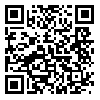Volume 24, Issue 3 (12-2021)
Hakim 2021, 24(3): 209-226 |
Back to browse issues page
Download citation:
BibTeX | RIS | EndNote | Medlars | ProCite | Reference Manager | RefWorks
Send citation to:



BibTeX | RIS | EndNote | Medlars | ProCite | Reference Manager | RefWorks
Send citation to:
Mosadeghrad A M, Kazemi F, Metanat S, Mosadeghrad A H, Afraz S, Ganjedanesh M R. Strategic analysis of Iran’s primary healthcare system in epidemics: A scoping review. Hakim 2021; 24 (3) :209-226
URL: http://hakim.tums.ac.ir/article-1-2136-en.html
URL: http://hakim.tums.ac.ir/article-1-2136-en.html
Ali Mohammad Mosadeghrad1 
 , Fatemeh Kazemi2
, Fatemeh Kazemi2 
 , Sepehr Metanat3
, Sepehr Metanat3 
 , Amir Hossein Mosadeghrad4
, Amir Hossein Mosadeghrad4 
 , Shabnam Afraz *
, Shabnam Afraz * 
 5, Mohammad Reza Ganjedanesh6
5, Mohammad Reza Ganjedanesh6 


 , Fatemeh Kazemi2
, Fatemeh Kazemi2 
 , Sepehr Metanat3
, Sepehr Metanat3 
 , Amir Hossein Mosadeghrad4
, Amir Hossein Mosadeghrad4 
 , Shabnam Afraz *
, Shabnam Afraz * 
 5, Mohammad Reza Ganjedanesh6
5, Mohammad Reza Ganjedanesh6 

1- Ph.D. Professor, Department of Health Management and Economics, School of Public Health, Tehran University of Medical Sciences, Tehran, Iran.
2- M.Sc. student, Department of Nursing Management, School of Nursing and Midwifery, Tehran University of Medical Sciences, Tehran, Iran.
3- MD. student, School of Medicine, Tehran University of Medical Sciences, Tehran, Iran
4- MD. student, School of Medicine, Artesh University of Medical Sciences, Tehran, Iran.
5- M.Sc s. student, Department of Health Management and Economics, School of Public Health, Tehran University of Medical Sciences, Tehran, Iran. ,Shabnam.afrraz@gmail.com
6- MD. student, School of Medicine, Tehran University of Medical Sciences, Tehran, Iran.
2- M.Sc. student, Department of Nursing Management, School of Nursing and Midwifery, Tehran University of Medical Sciences, Tehran, Iran.
3- MD. student, School of Medicine, Tehran University of Medical Sciences, Tehran, Iran
4- MD. student, School of Medicine, Artesh University of Medical Sciences, Tehran, Iran.
5- M.Sc s. student, Department of Health Management and Economics, School of Public Health, Tehran University of Medical Sciences, Tehran, Iran. ,
6- MD. student, School of Medicine, Tehran University of Medical Sciences, Tehran, Iran.
Abstract: (1453 Views)
Introduction: The primary health care system is the first point of contact for individuals, families and society with the health system, where basic and essential health services are provided in a place close to where people live or work. The primary health care system plays a critical role in responding to epidemics and should be strengthened. This study aimed to strategically analyse the Iranian primary health care system in responding to epidemics and to provide solutions to strengthen it.
Methods: This research was carried out using scoping review method. All studies related to the strengths, weaknesses, opportunities and threats of Iran’s primary health care system in responding to epidemics, indexed in PubMed, Scopus, Web of Science and ProQuest, SID and Magiran databases and Google Scholar search engine were searched using appropriate keywords and search strategies. Finally, 52 documents were selected and analyzed using framework analysis method.
Results: Overal, 18 strengths, 10 weaknesses, 17 opportunities and 14 threats were identified for Iran’s primary health care system in responding to epidemics. Besides, 62 actions were suggested to strengthen Iran’s primary health care system in responding to the epidemics, which were grouped into six categories: governance and leadership, financing, health workers, equipment and medicine, health information system, and primary health care delivery. Using the military health staff for deprived areas, home quarantine of the infected, training health workers, social and psychological support for workers and using tele-medical services are necessary to strengthen Iran’s primary health care system.
Conclusion: Iran’s primary health care system is facing many challenges in responding to epidemics. Policy makers and senior managers of the health system should strengthen the country’s primary health care system using the suggested strategies.
Methods: This research was carried out using scoping review method. All studies related to the strengths, weaknesses, opportunities and threats of Iran’s primary health care system in responding to epidemics, indexed in PubMed, Scopus, Web of Science and ProQuest, SID and Magiran databases and Google Scholar search engine were searched using appropriate keywords and search strategies. Finally, 52 documents were selected and analyzed using framework analysis method.
Results: Overal, 18 strengths, 10 weaknesses, 17 opportunities and 14 threats were identified for Iran’s primary health care system in responding to epidemics. Besides, 62 actions were suggested to strengthen Iran’s primary health care system in responding to the epidemics, which were grouped into six categories: governance and leadership, financing, health workers, equipment and medicine, health information system, and primary health care delivery. Using the military health staff for deprived areas, home quarantine of the infected, training health workers, social and psychological support for workers and using tele-medical services are necessary to strengthen Iran’s primary health care system.
Conclusion: Iran’s primary health care system is facing many challenges in responding to epidemics. Policy makers and senior managers of the health system should strengthen the country’s primary health care system using the suggested strategies.
Type of Study: Review |
Subject:
General
Received: 2022/04/13 | Accepted: 2022/12/1 | Published: 2022/12/1
Received: 2022/04/13 | Accepted: 2022/12/1 | Published: 2022/12/1
Send email to the article author
| Rights and permissions | |
 |
This work is licensed under a Creative Commons Attribution-NonCommercial 4.0 International License. |



